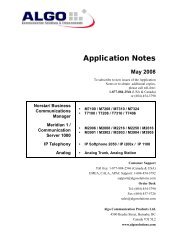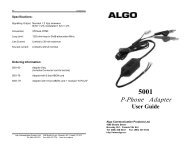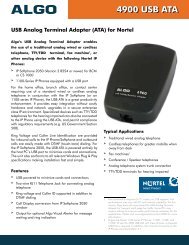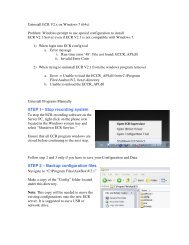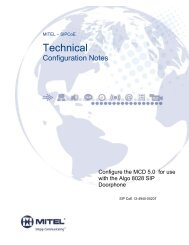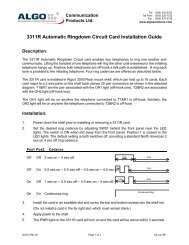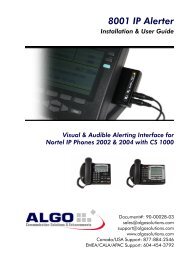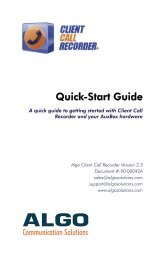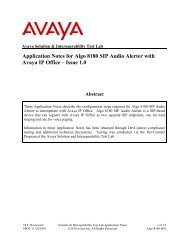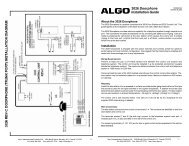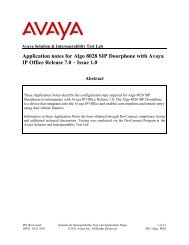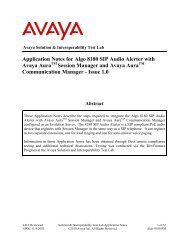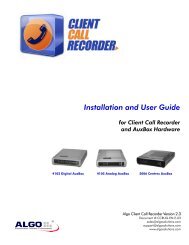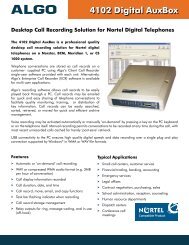Algo 8028 SIP Doorphone User Guide - Algo Communication Products
Algo 8028 SIP Doorphone User Guide - Algo Communication Products
Algo 8028 SIP Doorphone User Guide - Algo Communication Products
Create successful ePaper yourself
Turn your PDF publications into a flip-book with our unique Google optimized e-Paper software.
Important Safety Notice<br />
The <strong>8028</strong> <strong>SIP</strong> <strong>Doorphone</strong> is designed and tested to comply with EN 60950-1:2006 safety<br />
requirements.<br />
When the <strong>Doorphone</strong> Controller is connected to wiring that exits the building, there is<br />
potential risk of lightning induced electrical surges or high voltages from fault conditions.<br />
To reduce risk, outdoor wiring should be protected by Earth grounded conduit whenever<br />
possible.<br />
If outdoor wiring will be connected to the <strong>Doorphone</strong> Controller then the power supply provided<br />
with the <strong>Doorphone</strong> Controller must first be connected to a properly Earthed mains supply.<br />
Under no circumstances can the <strong>Doorphone</strong> Controller be disconnected from Earth ground while<br />
connected to outdoor wiring.<br />
Support<br />
<strong>Algo</strong> is pleased to offer telephone or email support relating to installation issues, applications<br />
assistance, or general product inquiries.<br />
<strong>Algo</strong> <strong>Communication</strong> <strong>Products</strong> Ltd.<br />
4500 Beedie Street<br />
Burnaby, British Columbia<br />
Canada, V5J 5L2<br />
support@algosolutions.com<br />
604.454.3792<br />
sales@algosolutions.com<br />
604.454.3790<br />
<strong>Algo</strong> products are warranted against defect in workmanship for a period of 12 months after<br />
installation not to exceed 18 months from date of manufacture.<br />
FCC Compliance<br />
This equipment has been tested and found to comply with the limits for a Class B digital device, pursuant to part 15<br />
of the FCC Rules. These limits are designed to provide reasonable protection against interference in a residential<br />
installation. This equipment generates, uses, and can radiate radio frequency energy and, if not installed and<br />
used in accordance with the instructions, may cause harmful interference to radio communications. However, there<br />
is no guarantee that interference will not occur in a particular installation. If this equipment does cause harmful<br />
interference to radio or television reception, which can be determined by turning the equipment off and on, the user<br />
is encouraged to try to correct the interference by one or more of the following measures: 1) Reorient or relocate<br />
the receiving antenna, 2) Increase the separation between the equipment and receiver, 3) Connect the equipment<br />
into an outlet on a circuit different from that to which the receiver is connected, or 4) Consult the dealer or an<br />
experienced radio/TV technician for help.<br />
- 2 -
Table of Contents<br />
Support . . . . . . . . . . . . . . . . . . . . . . . . . . . . . . . . . . . . . . . . . . . . . . . . . . 2<br />
FCC Compliance . . . . . . . . . . . . . . . . . . . . . . . . . . . . . . . . . . . . . . . . . . . 2<br />
Important Safety Notice . . . . . . . . . . . . . . . . . . . . . . . . . . . . . . . . . . . . . . 2<br />
Introduction .......................................4<br />
Features . . . . . . . . . . . . . . . . . . . . . . . . . . . . . . . . . . . . . . . . . . . . . . . . . 4<br />
Quick Install & Test .................................5<br />
Applications .......................................6<br />
Typical Applications for Auxiliary Inputs and Outputs . . . . . . . . . . . . . . . . 6<br />
Door or Gate Control Basics. ..........................8<br />
Door Release . . . . . . . . . . . . . . . . . . . . . . . . . . . . . . . . . . . . . . . . . . . . . 8<br />
Setup and Installation ..............................10<br />
Programming and Configuration. .....................11<br />
Web Interface Control Panel . . . . . . . . . . . . . . . . . . . . . . . . . . . . . . . . . 11<br />
NAT.............................................19<br />
STUN Server . . . . . . . . . . . . . . . . . . . . . . . . . . . . . . . . . . . . . . . . . . . . . 19<br />
Asterisk and other <strong>SIP</strong> Servers . . . . . . . . . . . . . . . . . . . . . . . . . . . . . . . . 19<br />
Auto-Provisioning (via TFTP) .........................20<br />
MD5 Checksum . . . . . . . . . . . . . . . . . . . . . . . . . . . . . . . . . . . . . . . . . . 20<br />
Generating a generic configuration file . . . . . . . . . . . . . . . . . . . . . . . . . 21<br />
Generating a specific configuration file . . . . . . . . . . . . . . . . . . . . . . . . . 21<br />
Connections and Lights .............................22<br />
Auxiliary Dry Contact Outputs . . . . . . . . . . . . . . . . . . . . . . . . . . . . . . . . 22<br />
Auxiliary Dry Contact Inputs . . . . . . . . . . . . . . . . . . . . . . . . . . . . . . . . . 22<br />
LED Details . . . . . . . . . . . . . . . . . . . . . . . . . . . . . . . . . . . . . . . . . . . . . . 23<br />
Connection Details . . . . . . . . . . . . . . . . . . . . . . . . . . . . . . . . . . . . . . . . 24<br />
Specifications .....................................25<br />
Related <strong>Doorphone</strong> <strong>Products</strong> .........................28<br />
- 3 -
Applications<br />
Typical Applications for Auxiliary Inputs and Outputs<br />
The <strong>8028</strong> architecture and digital link between the Door Station and Controller<br />
provides flexible options using the auxiliary inputs and outputs. These are some<br />
typical applications:<br />
Cancel Ring When Door Opened<br />
In a residential or warehouse installation it is not uncommon for the door to<br />
be answered in person before the phone is answered. Either Door Station or<br />
Control Unit inputs can be configured to cancel ring if the door is opened<br />
before a call is answered. This requires a normally closed or normally open<br />
contact to detect door open.<br />
Trigger Door Bell from Door Station<br />
When the Door Station call button is pressed, either (or both) the Door Station<br />
or Control Unit dry contact output can be configured to activate a door bell or<br />
auxiliary alerting system in addition to phone ring.<br />
Trigger Door Station from External Button/Event<br />
Either the Control Unit or Door Station can accept a dry contact closure to<br />
activate the <strong>Doorphone</strong> as if the call button had been pressed. This could be an<br />
external doorbell button, PIR detector, or some other system.<br />
Cancel Door Open Relay once Door Opened<br />
The door opening control can be set for activation (using the `Open Code’) up<br />
to 30 seconds (set by the `Relay Time’ setting) to allow sufficient time for entry.<br />
For security, the <strong>8028</strong> <strong>Doorphone</strong> can be configured to cancel Door Opening<br />
once the door is opened to prevent “tailgating” by unauthorized personnel.<br />
Unlock Door Indefinitely until Canceled<br />
The door opening control can be set to unlock indefinitely (using the `Latch<br />
Open Code’) until canceled (using the `Release Code’) that locks it again. This<br />
allows an entrance to be used repeatedly for a period of time without requiring<br />
multiple activations of the door control relay.<br />
- 6 -
Anti-Door Tamper<br />
A feature of the <strong>8028</strong> <strong>Doorphone</strong> is to ring the telephone(s) with a warning alert<br />
in the event a door is ajar due to tampering (such as a door blocked open after<br />
being legitimately released for a visitor).<br />
In-Use and Ring<br />
Either the Control Unit or Door Station can be configured to provide a dry<br />
contact output during ring or in-use for channel selection (typically) of third<br />
party video monitoring systems.<br />
- 7 -
Door or Gate Control Basics<br />
Control contacts are provided from the <strong>Doorphone</strong> Controller and are typically<br />
used for door strike activation or gate control. For security, the door control<br />
relay is located in the Controller to avoid entry by tampering. The Door Station<br />
dry contact output (OUT) may be configured for ‘low security’ gate control<br />
requiring a low current dry contact.<br />
Door Release<br />
Door release typically involves energizing or de-energizing a door strike which<br />
pivots to allow a locked door to open without retraction of the latch bolt. There<br />
are two different types of door strikes:<br />
• “Fail Locked” (or “Fail Secure”)<br />
• “Fail Unlocked” (or “Fail Safe”)<br />
Fail Locked / Fail Secure Electric Strike<br />
These require power to release and<br />
remain locked during power failure. The<br />
door may still normally be opened from<br />
the outside with a key, or from inside<br />
without a key. The door control relay is<br />
used to apply power to release the door.<br />
Fail Unlocked / Fail Safe Electric Strike<br />
These (as well as magnetic locks), require<br />
power to lock and become unlocked<br />
during power failure. The door control<br />
relay is used to maintain power to the<br />
door lock (NC and C contacts) which is<br />
interrupted to release the door. Magnetic<br />
locks may require override systems to<br />
allow safety exit in the event of fire.<br />
- 8 -<br />
24V 0.3A<br />
“Fail Locked”<br />
24 Vdc 0.2 A Typical<br />
24V 0.3A<br />
“Fail Unlocked”<br />
24 Vdc 0.2 A Typical<br />
Door<br />
Strike
Programming and Configuration<br />
Connection to Network and Obtaining IP Address<br />
After connecting the <strong>8028</strong> to a network port, watch for the PWR light to start<br />
winking (on and blinking off) during initialization. The <strong>8028</strong> will then attempt<br />
to obtain an IP address from the DHCP server. If unsuccessful, the <strong>8028</strong> will<br />
default to the fixed IP address 192.168.1.111.<br />
To find the IP address of the <strong>8028</strong>, press the Call Button on the Door Station.<br />
The <strong>8028</strong> will speak its IP address if it has not yet been configured with a <strong>SIP</strong><br />
Server address. Alternatively, search the network using the <strong>8028</strong> Locator Tool<br />
available for download from www.algosolutions.com/<strong>8028</strong>locator.<br />
Web Interface Control Panel<br />
The <strong>8028</strong> is programmed using a web interface tool accessed by entering the<br />
<strong>8028</strong> IP address into a browser. Using this interface, you can configure the<br />
<strong>8028</strong> network settings and select the desired options. These settings survive<br />
power cycling and may be programmed in advance prior to site installation.<br />
- 11 -
Note: This page left intentionally blank.<br />
- 27 -



